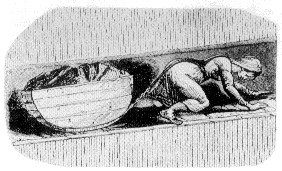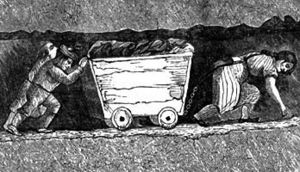Mines and Collieries Act 1842 facts for kids
| Act of Parliament | |

|
|
| Long title | An Act to prohibit the Employment of Women and Girls in Mines and Collieries, to regulate the Employment of Boys, and to make other Provisions relating to Persons working therein. |
|---|---|
| Citation | 5 & 6 Vict. c. 99 |
| Territorial extent | United Kingdom |
| Dates | |
| Royal assent | 10 August 1842 |
| Other legislation | |
| Repealed by |
|
|
Status: Repealed
|
|
| Text of statute as originally enacted | |
The Mines and Collieries Act 1842, also known as the Mines Act 1842, was an important law passed in the United Kingdom. This Act made it illegal for women and girls of any age to work underground in mines. It also set a minimum age of ten for boys working underground. This law was created because a report showed the terrible working conditions for children in mines.
The Mines Act of 1842
At the start of the 1800s, coal mining was very basic. Men, women, and children all worked in dangerous conditions. In 1841, about 216,000 people worked in mines. Women and children often worked 11 or 12 hours a day. They earned less money than men.
Why the Act Was Needed
The public learned about the bad conditions in mines after an accident in 1838. This happened at Huskar Colliery near Barnsley. A stream overflowed into the mine after a big thunderstorm. This caused the death of 26 children. Eleven girls aged 8 to 16 died, along with 15 boys aged 9 to 12. Queen Victoria heard about this disaster and ordered an investigation.
Investigating the Mines
In 1840, a special group was formed to investigate mine conditions. This group was led by Lord Ashley. They visited mines and mining towns. They gathered information, sometimes even when mine owners did not want them to.
The group's report was published in May 1842. It included drawings and personal stories from miners. People in Victorian society were shocked by what they read. They learned that children as young as five or six worked as trappers. These children opened and closed ventilation doors deep in the mine. Older children became hurriers, pushing and pulling heavy coal tubs. The report also highlighted how girls and women worked in ways that shocked society at the time. This helped make sure the new law was passed.
Not everyone agreed with the new law. Lord Londonderry, who owned coal mines, tried to stop the bill. He managed to make some changes to the law. But the bill still passed in the House of Lords on August 1, 1842.
What the Act Changed
The Mines and Collieries Act 1842 brought important changes:
- No females (women or girls) could work underground in mines.
- No child under 10 years old could work underground.
- Young workers (called parish apprentices) between 10 and 18 years old could still work in mines.



